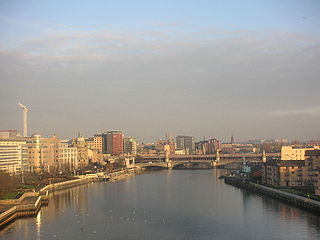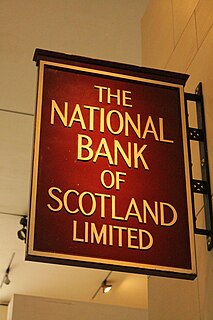Related Research Articles

The River Clyde is a river that flows into the Firth of Clyde in Scotland. It is the eighth-longest river in the United Kingdom, and the second-longest in Scotland. Traveling through the major city of Glasgow, it was an important river for shipbuilding and trade in the British Empire. To the Romans, it was Clota, and in the early medieval Cumbric language, it was known as Clud or Clut, and was central to the Kingdom of Strathclyde.
A merchant bank is historically a bank dealing in commercial loans and investment. In modern British usage it is the same as an investment bank. Merchant banks were the first modern banks and evolved from medieval merchants who traded in commodities, particularly cloth merchants. Historically, merchant banks' purpose was to facilitate and/or finance production and trade of commodities, hence the name "merchant". Few banks today restrict their activities to such a narrow scope.

Clydesdale Bank is a trading name used by Clydesdale Bank plc for its retail banking operations in Scotland.
Crédit Agricole Corporate and Investment Bank is Crédit Agricole's corporate and investment banking entity. With a staff of 7,395 employees in 32 countries, Crédit Agricole CIB is active in a broad range of capital markets, investment banking and financing activities. Clients are primarily corporates, governments, and banks, with a small footprint in the investor segment.
The Standard Bank of South Africa Limited is a South African financial services group and is Africa’s biggest lender by assets. The company's corporate headquarters, Standard Bank Centre, is situated in Simmonds Street, Johannesburg.

James Marwick was an original founder of an accounting office that became one of the Big Four auditors, KPMG.
Adam and Company is a trading division of The Royal Bank of Scotland plc catering for the needs of private bank customers based in the United Kingdom. It offers a range of private banking services including discretionary investment management and financial planning services to high net worth clients in the UK.

The Royal Bank of Scotland is a major retail and commercial bank in Scotland. It is one of the retail banking subsidiaries of NatWest Group, together with NatWest and Ulster Bank. The Royal Bank of Scotland has around 700 branches, mainly in Scotland, though there are branches in many larger towns and cities throughout England and Wales. The bank is completely separate from the fellow Edinburgh-based bank, the Bank of Scotland, which pre-dates the Royal Bank by 32 years. The Royal Bank of Scotland was established in 1724 to provide a bank with strong Hanoverian and Whig ties.
The City of Glasgow Bank is now largely known for its spectacular collapse in October 1878, ruining all but 254 of its 1,200 shareholders, whose liability was not limited.

The Riverside Museum is the location of the Glasgow Museum of Transport, at Pointhouse Quay in the Glasgow Harbour regeneration district of Glasgow, Scotland. The building opened in June 2011. The museum won the 2013 European Museum of the Year Award.

A bank is a financial institution that accepts deposits from the public and creates a demand deposit while simultaneously making loans. Lending activities can be performed either directly or indirectly through capital markets.

The National Bank of Scotland was founded as a joint stock bank in 1825. Based in Edinburgh, it had established a network of 137 branches at the end of its first hundred years. In 1918 the bank was bought by Lloyds Bank, although it continued to operate as an independent institution until 1959, when it merged with the Commercial Bank of Scotland to become the National Commercial Bank of Scotland. Ten years later the National Commercial Bank merged with the Royal Bank of Scotland.

The Leith Banking Company was a bank based in the town of Leith, Scotland, which opened in 1793 and was forced to merge due to debt in 1842. The bank was established by 18 partners, mainly merchants, on 1 January 1793. Partners James Ker and Henry Johnston were joint managers. Sir Walter Scott is believed to have been an account holder.

The Industrial Revolution in Scotland was the transition to new manufacturing processes and economic expansion between the mid-eighteenth century and the late nineteenth century. By the start of the eighteenth century, a political union between Scotland and England became politically and economically attractive, promising to open up the much larger markets of England, as well as those of the growing British Empire, resulting in the Treaty of Union of 1707. There was a conscious attempt among the gentry and nobility to improve agriculture in Scotland. New crops were introduced and enclosures began to displace the run rig system and free pasture. The economic benefits of union were very slow to appear, some progress was visible, such as the sales of linen and cattle to England, the cash flows from military service, and the tobacco trade that was dominated by Glasgow after 1740. Merchants who profited from the American trade began investing in leather, textiles, iron, coal, sugar, rope, sailcloth, glass-works, breweries, and soap-works, setting the foundations for the city's emergence as a leading industrial center after 1815.
Events from the year 1836 in Scotland.
Virgin Money UK plc is a holding company that owns Clydesdale Bank plc, which in turn trades as Clydesdale Bank, Yorkshire Bank and Virgin Money in the United Kingdom. It was formed as CYBG plc by National Australia Bank (NAB) in February 2016, in advance of the divestment of its UK business through a stock market flotation. It is listed on the London Stock Exchange and Australian Securities Exchange; it is also a constituent of the FTSE 250 Index.

Holt's Military Banking is a trading name of The Royal Bank of Scotland, a subsidiary of NatWest Group, offering dedicated banking facilities to service personnel in the United Kingdom and on operational tours of duty overseas. It can trace its origins to a Mr. Vesey, army agent to the 23rd Regiment of (Light) Dragoons, in Dublin in 1802.
Andrew Cochrane of Brighouse (1693–1777) was an 18th-century tobacco lord and a slave trade owner who served as Lord Provost of Glasgow three times, more than any other person: 1744/5, 1748/9, and 1760/1.
Robert Carrick of Braco (1737–1821) was an 18th-century Scottish banker, who was one of the richest men ever to have lived in Scotland. A cold, hard man, he was a notorious miser.
References
| This article about a company of Scotland is a stub. You can help Wikipedia by expanding it. |